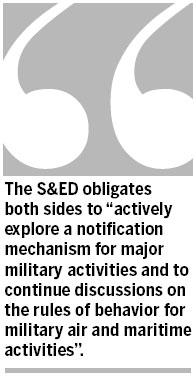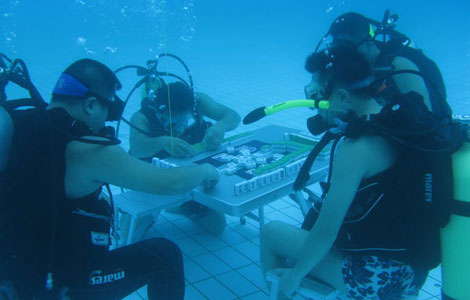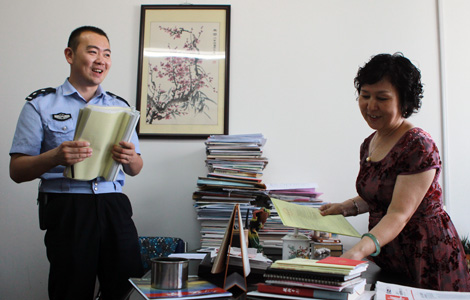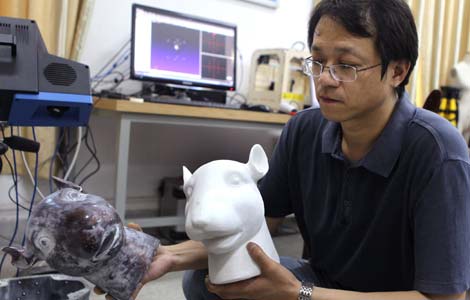A mission that is possible
Updated: 2013-08-14 07:55
By Zhou Bo (China Daily)
|
||||||||

China and the US should seek to extend their cooperation in traditional and nontraditional security areas
The China-US military relationship is not short of problems or crises. But at present the momentum is definitely in the right direction.
The China-US Strategic and Economic Dialogue in July concluded with 91 outcomes from the strategic track, and both sides said they are "committed to strengthening the military-to-military relationship and to make efforts to raise the relationship to a new level".
Chinese Defense Minister General Chang Wanquan and Naval Commander Admiral Wu Shengli are expected to visit the United States this year.
But there are still a lot of issues to be overcome to build greater mutual trust.
The S&ED obligates both sides to "actively explore a notification mechanism for major military activities and to continue discussions on the rules of behavior for military air and maritime activities".
But does that include the US' deployment of troops or weapons systems on China's periphery as part of its rebalancing to Asia? Does it include anti-satellite missile tests, such as the one conducted by China in 2007 and by the US in 2008? On the rules of behavior for military air and maritime activities, does this include US reconnaissance in China's exclusive economic zone and the Chinese naval flotilla's unannounced but legitimate passage through the Straits of Japan?
To make things more complicated, the same term may have different meanings for the two militaries. For example, freedom of navigation is acknowledged by both China and the US according to United Nations Convention on the Law of the Sea, but the Chinese believe that military activities cannot be simply categorized as freedom of navigation and cannot infringe on a coastal state's national security interests, while the US maintains that military activities and overflights and other internationally lawful uses of the sea fall within the freedoms of navigation.
Promoting cooperation in traditional security areas is challenging, since it requires greater trust. Still, it can be done. In 1998 China and the US signed an agreement not to target their nuclear weapons at each other. Could they go a step further to sign a non-first-use agreement, such as the one between China and Russia?
Over the years, Beijing has asked the US to stop selling arms to Taiwan and the US has called on Beijing to withdraw short-range missiles aimed at Taiwan. Now that cross-Straits relations have improved, perhaps it is time for the US to promise not to sell arms to Taiwan and Beijing to agree to withdraw the missiles. Could the US lift the restrictions in the Defense Authorization Act for Fiscal Year 2000 and the Delay Amendment that restricts the US military's exchanges with People's Liberation Army?
Meanwhile bilateral and multilateral exercises should continue. Last year saw the two militaries engage in bilateral counter-piracy exercises in the Gulf of Aden and a joint tabletop exercise in humanitarian assistance and disaster relief in Chengdu. In April, a Chinese military spokesman announced that in 2013, the two militaries will conduct a joint disaster relief exercise and another counter-piracy naval exercise in the Gulf of Aden. China has also accepted the invitation from the US to attend next year's Rim of the Pacific Exercise, the world's largest international naval exercise, which will take place in the waters off Hawaii. China and the US also participate in regional platforms such as the Association of Southeast Asian Nations Regional Forum and the Asian Defence Ministers Meeting-Plus, which brings together the defense ministers from the members of ASEAN, plus the US, China, Russia, Japan, India, South Korea, Australia and New Zealand.
To build bridges, non-traditional security is a "soft" area where the two countries can work together to establish greater trust. Among their ongoing joint efforts in anti-terrorism, military medicine, pandemic disease control, humanitarian aid and disaster relief, counter-piracy is a good example of cooperation. On Nov 22, 2010, the USNS Lewis and Clark and USS Winston Churchill provided substantial help to the PLA Navy in relieving the Chinese vessel Taiankou, which was attacked by pirates in the Gulf of Aden. Piracy in the gulf has dwindled considerably thanks to the joint efforts of international naval forces including China and the US. Both countries also participated in the first Humanitarian Assistance and Disaster Relief and Military Medicine Exercises in Brunei in June, which were staged under the framework of the ADMM-Plus. These exercises should be institutionalized to enhance interoperability and to promote capacity building.
More can also be done to cooperate in peacekeeping. To date, China is the largest troop and police contributor among the five permanent members of the UN Security Council with 22,000 military personnel dispatched to 23 peacekeeping missions. The US is the largest contributor of funds, paying $ 7.33 billion, more than 28 percent of the total, for the fiscal year July 1, 2012 to June 30, 2013. But interaction between the two is rare. In spite of a 23-year involvement, Chinese peacekeeping is primarily confined to providing engineering, logistic and medical support to avoid the sensitive issue of sending "combat troops". However, on June 27, 2013, for the first time in history, China announced that it would send a security force to be deployed in Mali. Not only can the two militaries exchange information about their experiences, they can also provide support and training to the regional peacekeepers of the African Union who need assistance due to lack of funds, equipment and expertise.
At their Sunnyland summit Chinese President Xi Jinping and US President Barack Obama pledged to establish a "new type of relationship between the major powers", this will require unremitting and even painstaking efforts from the two militaries to deepen strategic trust.
The author is an honorary fellow with Center of China-American Defense Relations, Academy of Military Science. www.chinausfocus.com
(China Daily USA 08/14/2013 page11)

 Huawei unveil Ascend P6 smartphone in Vienna
Huawei unveil Ascend P6 smartphone in Vienna
 That's one cool game of mahjong
That's one cool game of mahjong
 Isinbaeva leads harvest day for host Russia
Isinbaeva leads harvest day for host Russia
 Perseid meteor shower puts on show in night sky
Perseid meteor shower puts on show in night sky
 Bird flu, slowdown hit sales at fast-food chains
Bird flu, slowdown hit sales at fast-food chains
 PetroChina poised to dominate Iraqi oil
PetroChina poised to dominate Iraqi oil
 Marriage attitudes slowly change
Marriage attitudes slowly change
 On frontline of fight against crime
On frontline of fight against crime
Most Viewed
Editor's Picks

|

|

|

|

|

|
Today's Top News
Brazil demands clarifications on NSA surveillance
2nd-generation ID cards to include fingerprints
Chinese students boost boarding business in US
TCM chain probed after illegal house exposed
Friends of accused Boston bomber due in court
Economic hub on Bohai Bay
PM to visit China for milk scare
Donors of organs easing transplant shortages
US Weekly

|

|




